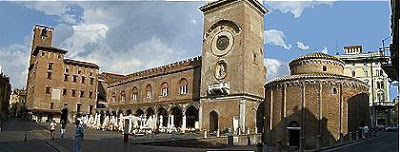A visit to Mantua (Mantova in Italian), located in the south east of the region of Lombardy, is ideal for a weekend getaway or an overnight stop in an Italian trip. Whilst the city is studied by every student of renaissance art history, it is a destination that is largely overlooked by foreign travellers, as it often becomes overshadowed by its much larger, and more magnificent, competitors on the Italian peninsula. Mantova is a small city (circa 50,000 inhabitants) and so it doesn’t take very long to feel at home and have visited the major sites, but with artistic wonders and a scrumptious cuisine, it is worth the visit. It was entered in the list of Unesco world heritage sites in 2008.
Geographically it is unusual, surrounded by lakes, and was unattractive swampy marsh land until the Corradi family took over the area in the fourteenth century and created their Marquisate in the early fifteenth century. The ruling family became best known by their adopted name of Gonzaga, hailing from their eponymous town of origin close by. The Gonzaga family (dukes from 1530), ruled until 1707 when the duchy passed to the Hapsburgs.
During the renaissance period, in the fifteenth and sixteenth century, the Gonzaga family were some of the most important patrons of Renaissance art, and they long cultivated a court which included some of the most illustrious artists and intellectuals of the time. Andrea Mantegna, the court painter from 1460-1506 (he was the brother-in-law to Giovanni and Gentile Bellini – the most important painters of the Venetian Republic in the second half of the fifteenth century), succeeding from much acclaimed Pisanello, and Leon Battista Alberti (the great Renaissance theorist and architect from Florence), constructed the Basilica Sant’Andrea, a triumphant display of the new Renaissance humanist style. In the 1500’s, Giulio Romano, the most gifted of artists in Raphael’s workshop in Rome, who continued the workshop commissions after the great master’s death in 1520, was the court architect and painter in Mantua from the 1520’s. His most significant and most famous work was the architecture and decoration of Palazzo Te, the Gonzaga villa residence, once located outside the city, now a short walk from the Ducal palace.
 |
| The medieval castle that became the ducal palace of the Gonzaga family |
The palazzo ducale in the centre of the city, where the Gonzaga family lived, is huge. The magnificent medieval castle was continuously enlarged throughout the centuries, as can be seen from the changes in the artistic building styles. The most exquisite room is the ‘camera picta’ (the painted room) later dubbed the ‘camera degli sposi’ (the wedding chamber), painted by Andrea Mantegna in 1467-1473. The ceiling is the first example of the trompe l’oeil technique in painting and appears to extend up into the outside with a wonderful balcony where figures and putti peer down onto the viewer below.
 |
| Ceiling from the ‘camera picta’ called ‘camera degli sposi’ by Andrea Mantegna finished in 1474 |
The two decorated walls depict the ruling family, Ludovico and Barbara Gonzaga; on the east wall the family together with courtiers and dwarf…
 |
| East wall of the camera picta |
and on the north wall, Ludovico and his children, most importantly his son, Francesco, recently elected as cardinal.
 |
| North wall of the camera picta |
Another ‘must see’ in the ducale palace is the studiolo (study) of one of the most cultured, famous and politically active women of her era, Isabella d’Este, the wife of Marquis Francesco II Gonzaga.
 |
| Portrait of Isabella d’Este by Titian |
Daughter of the duke of Ferrara (another beautiful and important Renaissance centre not too distant from Mantua), Isabella was intelligent and extremely well educated (she was fluent in Latin and Greek), and friend of humanist scholars and artists. She was regent until her son became of age. Isabella commissioned two small private rooms for contemplation and meditation on the ground floor of the palace, along with an intimate garden space, for her envious collection of ancient and modern works of art. Her ‘studiolo’ (study) rivaled those of her male counterparts in the other Italian centres. The walls were lined with paintings by some of the most important artists of the day; Mantegna, Giovanni Bellini, Correggio, and Perugino. The cabinets held an impressive collection of ancient and modern gems, cameos and artifacts. Today, there is only the architectural shell to be seen. However, a little imagination and one can almost hear Isabella somewhere around the corner.
The Gonzaga country structure and stables, located outside the old city’s walls, was renovated by Giulio Romano and transformed into what it is today by the Marquis Federico II (son of Isabella d’Este and Francesco II Gonzaga) who was also to become the first Duke of Mantua.
 |
| Palazzo Te |
The residence, called ‘Palazzo Te’ after the name of the island on which it was built, ‘Tejeto’ abbreviated to Te (the water canals were subsequently filled in), was made as a place for fun and frolicking for himself and his mistress the Marquise Isabella Boschetti. This explains the subject choice for the exquisite decoration of one of the rooms dedicated to Cupid (Amor) and Psyche.
 |
| Cupid and Psyche Bacchanalian feast by Giulio Romano in one of the rooms of the Palazzo Te |
Hand in hand with the magnificent art discoveries comes the food culture of Mantua, well worth some studious attention. It is the home of pork and the quality of the cold cuts and meats from here is known all over Italy.
A good starter is a plate of mixed salames. A must for the first course is the tortelli di zucca which is delightfully sweet, and/or the maccheroni con stracotto (meat cooked over a long period of time – often donkey or horse meat is used).
| tortelli di zucca and maccheroni con stracotto |
Well known favourites for the second course is cotecchino (an oversize rich, fresh sausage about 3 inches wide and 9 inches long) which is boiled and served hot, most often with polenta.
| cotecchino and stinco di maiale |
The stracotto di cavallo (horse steak) and the stinco di maiale (lamb shanks) are popular main dishes also, washed down with local lambrusco wine (red fizzy wine).Bollito is another great favourite served with mostarda, and is various pork and beef cuts boiled and served with candied fruit such as apples, pears, pumpkin and melon, and a mustard syrup (mostarda is also fabulous with cheese). The typical deserts from here are sbrisolona (a buttery almond biscuit served in broken pieces).
 |
| Sbisolona – the almond butter biscuit |
or the torta di tagliatelle (a pastry base with a filling made from butter, almonds and sugar and topped with tagliatelle).
 |
| Torta di tagliatelle |
I stayed at the ‘B & B Casa del Teatro’, conveniently located a few minutes' walk from both the train station and the ducal palace. Cosy and comfy, completely renovated and elegant, it was perfect. The slow food restaurant where I ate is called Due Cavallini (Via Sainitro 5, Tel: +39 0376 322084)





